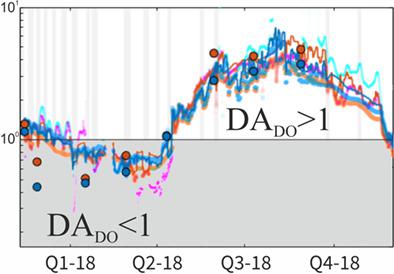当前位置:
X-MOL 学术
›
Hydrol. Process.
›
论文详情
Our official English website, www.x-mol.net, welcomes your
feedback! (Note: you will need to create a separate account there.)
Seasonal and short‐term controls of riparian oxygen dynamics and the implications for redox processes
Hydrological Processes ( IF 2.8 ) Pub Date : 2021-01-20 , DOI: 10.1002/hyp.14055 Guilherme E. H. Nogueira 1 , Christian Schmidt 1, 2 , Nico Trauth 1, 3 , Jan H. Fleckenstein 1
Hydrological Processes ( IF 2.8 ) Pub Date : 2021-01-20 , DOI: 10.1002/hyp.14055 Guilherme E. H. Nogueira 1 , Christian Schmidt 1, 2 , Nico Trauth 1, 3 , Jan H. Fleckenstein 1
Affiliation

|
Riparian zones are highly‐dynamic transition zones between surface water (SW) and groundwater (GW) and function as key biogeochemical‐reactors for solutes transitioning between both compartments. Infiltration of SW rich in dissolved oxygen (DO) into the riparian aquifer can supress removal processes of redox sensitive compounds like NO3−, a nutrient harmful for the aquatic ecosystem at high concentrations. Seasonal and short‐term variations of temperature and hydrologic conditions can influence biogeochemical reaction rates and thus the prevailing redox conditions in the riparian zone. We combined GW tracer‐tests and a 1‐year high‐frequency dataset of DO with data‐driven simulations of DO consumption to assess the effects of seasonal and event‐scale variations in temperature and transit‐times on the reactive transport of DO. Damköhler numbers for DO consumption (DADO) were used to characterize the system in terms of DO turnover potential. Our results suggest that seasonal and short‐term variations in temperature are major controls for DO turnover and the resulting concentrations at our field site, while transit‐times are of minor importance. Seasonal variations of temperature in GW lead to shifts from transport‐limited (DADO > 1) to reaction‐limited conditions (DADO < 1), while short‐term events were found to have minor impacts on the state of the system, only resulting in slightly less transport‐limited conditions due to decreasing temperature and transit‐times. The data‐driven analyses show that assuming constant water temperature along a flowpath can lead to an over‐ or underestimation of reaction rates by a factor of 2–3 due to different infiltrating water temperature at the SW–GW interface, whereas the assumption of constant transit‐times results in incorrect estimates of NO3− removal potential based on DADO approach (40%–50% difference).
中文翻译:

季节性和短期控制河岸氧气动力学及其对氧化还原过程的影响
河岸带是地表水(SW)和地下水(GW)之间的高度动态过渡带,并且是溶质在两个舱室之间过渡的关键生物地球化学反应器。SW富含溶解氧(DO)到河岸含水层可以禁止象NO氧化还原敏感的化合物的去除方法的浸润3 -,一种高浓度对水生生态系统有害的营养素。温度和水文条件的季节性和短期变化会影响生物地球化学反应速率,从而影响河岸带的主要氧化还原条件。我们将GW示踪剂测试和DO的1年高频数据集与DO消耗的数据驱动模拟相结合,以评估温度和渡越时间的季节性和事件尺度变化对DO的反应性运输的影响。DO消耗的Damköhler数(DA DO)用于根据DO转换潜力来表征系统。我们的结果表明,温度的季节性和短期变化是溶解氧转化率及其在现场的最终浓度的主要控制因素,而运输时间次要的影响很小。GW中温度的季节性变化导致从运输受限(DA DO > 1)到反应受限条件(DA DO)的转变<1),虽然发现短期事件对系统状态的影响较小,但由于温度和运输时间的降低,只会导致运输受限的情况略有减少。数据驱动的分析表明,假设沿水径恒定的水温可能会导致反应速率高估或低估2-3倍,原因是SW-GW界面处的渗透水温度不同。渡越时间导致NO的不正确的估计3 -去除潜在基于DA DO的方法(40%-50%的差异)。
更新日期:2021-02-23
中文翻译:

季节性和短期控制河岸氧气动力学及其对氧化还原过程的影响
河岸带是地表水(SW)和地下水(GW)之间的高度动态过渡带,并且是溶质在两个舱室之间过渡的关键生物地球化学反应器。SW富含溶解氧(DO)到河岸含水层可以禁止象NO氧化还原敏感的化合物的去除方法的浸润3 -,一种高浓度对水生生态系统有害的营养素。温度和水文条件的季节性和短期变化会影响生物地球化学反应速率,从而影响河岸带的主要氧化还原条件。我们将GW示踪剂测试和DO的1年高频数据集与DO消耗的数据驱动模拟相结合,以评估温度和渡越时间的季节性和事件尺度变化对DO的反应性运输的影响。DO消耗的Damköhler数(DA DO)用于根据DO转换潜力来表征系统。我们的结果表明,温度的季节性和短期变化是溶解氧转化率及其在现场的最终浓度的主要控制因素,而运输时间次要的影响很小。GW中温度的季节性变化导致从运输受限(DA DO > 1)到反应受限条件(DA DO)的转变<1),虽然发现短期事件对系统状态的影响较小,但由于温度和运输时间的降低,只会导致运输受限的情况略有减少。数据驱动的分析表明,假设沿水径恒定的水温可能会导致反应速率高估或低估2-3倍,原因是SW-GW界面处的渗透水温度不同。渡越时间导致NO的不正确的估计3 -去除潜在基于DA DO的方法(40%-50%的差异)。











































 京公网安备 11010802027423号
京公网安备 11010802027423号